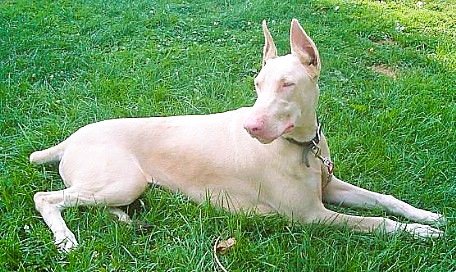The regal and striking White Doberman Pinscher is a breed that often captivates the hearts of many dog lovers. With their unique appearance and often misunderstood character, these dogs have long been subjects of fascination and admiration.
If you’re considering welcoming a white Doberman Pinscher into your home or already share your life with one of these magnificent creatures, this comprehensive guide is tailored just for you. Let’s explore everything you need to know about the white Doberman Pinscher, from their origins to their care and training.
History and Origins
The history of the white Doberman Pinscher is as intriguing as the breed’s controversial coat color. Their story starts in the early 20th century, when a genetic mutation gave rise to the first white Doberman Pinscher. Despite the American Kennel Club (AKC) and other major breed registries viewing the white coat as a disqualifying fault, these dogs have continued to thrive and have their place in the hearts of dog enthusiasts.

20 Facts about White Doberman Pinsher
Coat Color: White Doberman Pinschers have a distinctive all-white coat, which is a result of a genetic mutation that inhibits the production of melanin.
Genetic Mutation: The white coat color in Dobermans is associated with a genetic mutation in the SLC45A2 gene, which affects pigmentation.
Albino Traits: White Dobermans may exhibit some albino traits, such as pale skin, light blue or pink eyes, and a lack of pigmentation in the nose and paw pads.
Controversial Breeding: The breeding of white Dobermans is controversial within the Doberman Pinscher community, as it is not considered a standard color by major kennel clubs.
Health Concerns: White Dobermans are prone to certain health issues, including skin problems and sensitivity to sunlight due to their lack of pigmentation.
Temperament: Their temperament is generally similar to that of other Dobermans, known for being loyal, intelligent, and protective.
Not Recognized Standard: The American Kennel Club (AKC) and other major kennel clubs do not recognize the white Doberman as a standard color for the breed.
Breeding Restrictions: Some kennel clubs discourage or prohibit the breeding of white Dobermans due to the associated health concerns and deviation from the breed standard.
Historical Background: The first white Doberman named Padula’s Queen Sheba gained attention in the 1970s, sparking interest and controversy within the Doberman community.
Recessive Trait: The white coat color is a recessive trait, meaning both parents must carry the gene for a white Doberman to be produced.
Popularity: White Dobermans are relatively rare compared to the more common black, tan, or red Dobermans.
Eye Color Variations: White Dobermans may have blue, light brown, or heterochromatic (two different-colored) eyes.
Grooming Needs: Their white coat requires regular grooming to prevent staining and to maintain overall skin health.
Sun Sensitivity: Due to their lack of pigmentation, white Dobermans are more susceptible to sunburn, so it’s important to provide them with shade and sunscreen.
Companion Animals: White Dobermans can make excellent family pets and companions with proper socialization and training.
Legal Restrictions: In some countries, there may be legal restrictions on breeding or owning white Dobermans due to concerns about their health and potential for genetic disorders.
Exercise Requirements: Like other Dobermans, they are an energetic breed that requires regular exercise and mental stimulation.
Hereditary Deafness: Some white Dobermans may be prone to hereditary deafness, although not all white Dobermans are affected.
Distinct Appearance: The white coat color sets them apart from the traditional black and tan or red Doberman, making them easily recognizable.
Responsible Breeding: Ethical breeders of white Dobermans focus on health, temperament, and responsible breeding practices to minimize potential genetic issues.
The First White Doberman
The presence of the white coat in Dobermans stems from a specific gene mutation inherent in the breed. This is a naturally occurring event and not, as some may suggest, a result of crossbreeding.
Controversy Surrounding the White Doberman
The controversy over the white coat color is multifaceted, with some organizations opposing it on the grounds of potential health implications. While there are claims of increased deafness and blindness in white Dobermans, these challenges are not exclusive to the white phenotype and are present in all Doberman pinschers to a lesser degree.
Breeding and Preservation
White Doberman Pinscher breeders are often dedicated to preserving the breed’s health and furthering the understanding of the color mutation. Responsible breeding practices are crucial, and breeders continually work to minimize the risk of hereditary conditions.
Physical Characteristics
The defining feature of the white Doberman Pinscher may be its coat, but their physical traits extend beyond color. Understanding the physical profile of this breed is essential for both potential owners and those already caring for one.
The White Coat and Its Unique Challenges
White Dobermans have a distinctive appearance, characterized by their paleness. Their coat, while ethereal, requires special attention as it can be more sensitive to the sun and the environment.
Muscular and Athletic Build
The white Doberman Pinscher is a strong, muscular dog built for endurance. They are larger than life in both appearance and presence, with an athletic frame and a graceful gait that demands respect.
Ears and Tail
Historically, Doberman Pinschers’ ears are cropped and their tails docked. Although practices vary by region and personal preferences, these decisions are made for both practical and traditional reasons.
Temperament and Personality
Dobermans are well-known for their loyalty and protective nature. The white variety shares these traits and adds its own nuances to the mix.
Loyalty to Their Pack
White Dobermans have an innate sense of loyalty to their family. They make excellent companions and are known to form deep bonds with their owners.
Protective Instincts
White Doberman Pinschers excel as guard dogs due to their protective nature. They are alert, watchful, and not afraid to act if they sense any threat to their home or loved ones.
Socialization and Aggression
Like all dogs, socialization from an early age is crucial for a white Doberman’s development. Proper training and positive reinforcement can mitigate any potential aggression and help channel their protective instincts positively.
Health and Care
Caring for a white Doberman is a significant responsibility. It’s important to be aware of their unique health concerns and to provide them with the care they need to live a long and healthy life.
Common Health Issues
White Doberman Pinschers are prone to certain hereditary conditions, just like their traditionally colored counterparts. These include heart problems, hip dysplasia, and von Willebrand’s disease, among others.
Nutrition and Diet
Feeding your white Doberman a high-quality diet that meets their specific nutritional needs is vital. A healthy diet can contribute to their overall well-being and help prevent certain health issues.
Exercise and Physical Activity
White dobermans are highly energetic and require regular exercise to keep them both physically and mentally stimulated. Long walks, active play sessions, and even agility training can satisfy their need for activity.

Training and Exercise
Training a white Doberman requires patience, consistency, and positive reinforcement. Early training is especially important to manage their natural instincts and establish boundaries.
Socialization
Introducing your white Doberman Pinscher to new experiences, people, and animals helps them grow into well-rounded adults. Socializing your pup from the get-go sets the stage for a more harmonious relationship with the world around them.
Obedience Training
Basic obedience commands are essential for any dog, and the white Doberman is no exception. Training from an early age and continued reinforcement are necessary for good behavior and mutual enjoyment.
Exercise Routines
Developing an exercise regimen that suits their energy levels is key. From daily walks to mentally stimulating games, white Dobermans thrive with regular, engaging exercise that challenges their intelligence and keeps them on their paws.
Myths and Misconceptions
The white Doberman Pinscher is a breed that is often shrouded in myth and misunderstanding. Here, we debunk some of the most common misconceptions.
Myth: White Dobermans are Albinos
This is false; white Dobermans are not albinos. They are individuals who have inherited a specific gene that causes a dilution in the usual coat color.
Myth: White Dobermans are Always Blind and Deaf
While there is an increased prevalence of sensory issues among white Dobermans, not all are blind or deaf. Many live healthy, fulfilling lives with no sensory impairments.
Myth: White Dobermans are Aggressive Towards Strangers
Like all dog breeds, behavior is determined by upbringing and training. White Dobermans can be wary of strangers, but with proper socialization, they are not inherently more aggressive than any other breed.
Choosing a White Doberman Pinscher
Selecting a white Doberman Pinscher is a decision that requires consideration of several factors. Responsible pet ownership begins with choosing a breeder and a pup that align with your values and lifestyle.
Finding a Reputable Breeder
It’s crucial to do your research and find a breeder with a sound reputation and a commitment to the breed’s health and welfare.
Male or female?
The decision between a male or female white Doberman Pinscher can depend on your household dynamics, personal preference, and the individual dog’s temperament and size.
Puppy or adult?
Deciding to bring a puppy or an adult dog into your life has its pros and cons. Consider your experience level, lifestyle, and time commitment before making a choice.
Conclusion
Welcoming a white Doberman into your home is the start of a fulfilling journey that requires dedication and love. By understanding their background, unique traits, and requirements, you can ensure you’re equipped to provide the best possible life for your white warrior. Embrace the adventure, and enjoy the bond that will undoubtedly form between you and your new four-legged friend.
FAQs
Still have questions about white Doberman Pinschers? Here are some answers to common inquiries:
Q: Are white Doberman Pinschers good with children and other pets?
A: White Dobermans can be great with children and other pets if they are raised with them and socialized properly. However, it’s important to always supervise interactions between dogs and young children.
Q: What kind of home environment is best for a white Doberman?
A home with a secure yard and plenty of space for regular exercise is ideal for a white Doberman. They thrive in environments where they can burn off their energy and where there’s a clear order and rules to follow.
Q: How long do white Doberman Pinschers live?
A: White Dobermans generally have a lifespan of 10 to 13 years, which is typical for the breed. Genetics, diet, exercise, and overall care can all influence their longevity.




